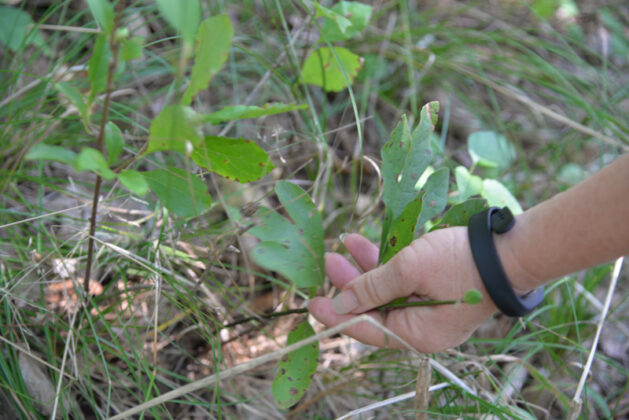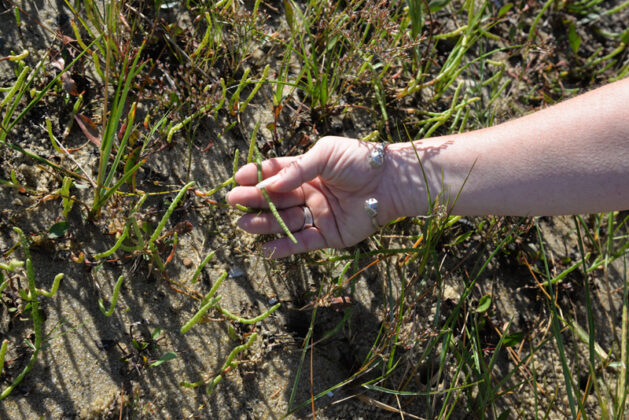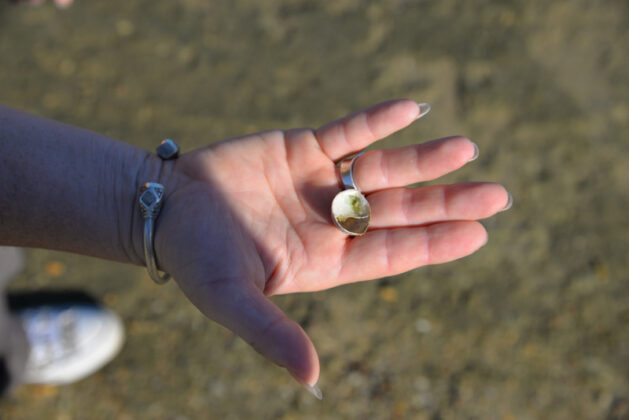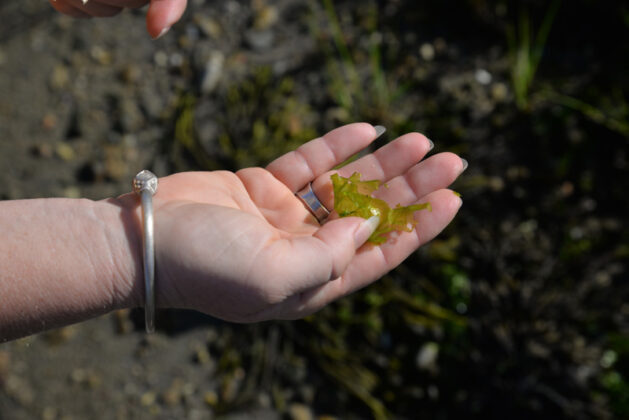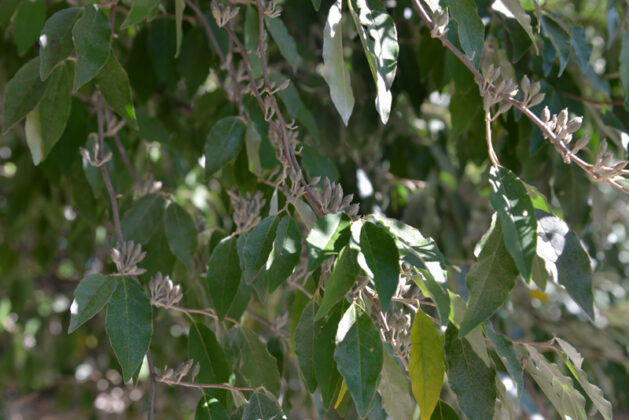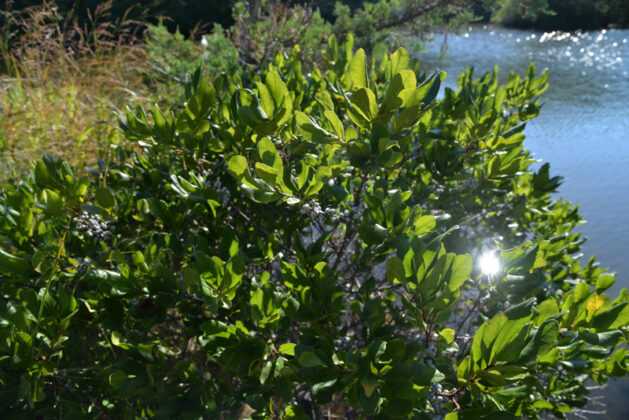Take a walk out in the woods or along a stretch of beach, and you’re sure to see a ton of wild edibles — it’s all about knowing what to look for.
Luckily for Islanders, there are knowledgeable wilderness experts here who specialize in foraged foods, and can provide hands-on experiences to those who want to learn. Additionally, a number of folks have written helpful guidebooks with illustrations and distinctive traits of certain wild edibles. The first step is to educate yourself, then head out into the wild.
Rebecca Gilbert of Native Earth Teaching Farm is one such expert, who has spent her entire life foraging on her property in Chilmark. Gilbert specializes in common edible weeds, and her book, “Weedy Wisdom for the Curious Forager: Common Wild Plants to Nourish Your Body and Soul,” is a highly endorsed resource to start with.
“You can certainly go looking for rare things out in the woods, but my focus is on the weeds that are already in the garden and the lawn and on edges of the yard,” Gilbert explained. For Gilbert, every wild edible has its ideal season for foraging. Right now, she has been appreciating the purslane, an annual weed that, according to her, has many tasty uses. Purslane plants remain succulent when a lot of other wild edibles begin to dry up and become highly fibrous or woody. Gilbert is eating a lot of purslane, as the spring and earlier summer weeds like lamb’s quarters and amaranth go into their seed stage.
When heading out into nature to forage, oftentimes you take what you can get (always in moderation). It’s not like going to the grocery store and picking out exactly what you need for a recipe, Gilbert said — foraging is less selective, and more about opportunity and timing. “You go out there, see what there is. Maybe you pick a mixture, a mess of greens. The whole process tends to be creative, picking forest food,” Gilbert said.
As the years go by at Native Earth Teaching Farm, the wild plant and animal ecology is constantly changing. Gilbert has witnessed a lot of those changes over time, and said that kind of awareness of history lets you know whether something is becoming more or less common. “Sometimes that is a good indicator of whether you should really be pursuing it or not,” Gilbert said. “Some of the things that used to be staple foods are now really rare.”
Just as foragers and land conservation organizations will tell you, foraging for invasive species is always a better bet than looking for some of the less common native species that are under threat of being overtaken. Part of her practice is to target these plentiful weeds in order to bring the environment into greater balance, rather than knocking it farther out of balance. She said if you are reducing the load of invasive and immigrant plants, you are making more room for the natives that struggle to keep up with invasives. “You can surely eat garlic mustard, it’s really delicious in the spring. Knotweed is also very good in the spring, and has shown some promise in helping people with Lyme disease,” Gilbert said. “A lot of these herbs and wild plants have potential medicinal benefits, as well.”
Gilbert also loves to use different methods of processing and preserving wild edibles. Her favorite way of pickling is called lacto-fermentation. She said lacto-fermentation is beneficial for your microbiome — your inner ecosystem, as she calls it. Gilbert’s mother would harvest purslane, pull the leaves off to make a salad or a relish, then throw the crunchy stems in a jar of old pickle juice. After a couple of days, the purslane stems taste just like pickles, and maintain their nutritional value. “A delicious and healthy snack,” Gilbert said.
For the Islands’ director of Mass Audubon, Suzan Bellincampi, identification skills are key. In general, she said it’s extremely important to know the distinctive characteristics of wild edibles before going out to forage. Bellincampi suggested getting a hard-copy reference from a reliable resource, like “Weedy Wisdom” or a similar book. She warned folks to be wary of phone apps that can sometimes be inaccurate, and lead to people picking the wrong wild edible or foraging for it at the wrong time. The Island is covered in berries scattered throughout the understory — prickly dewberry, high- and low-bush blueberry, and black huckleberry, just to name a few.
In the spring, wild grapes are plentiful. Harvest the leaves to be used in grape leaf recipes, and when the fruits come, you can make all sorts of different things. “For my wedding, I did the ‘grape escape,’ which was grape-infused vodka. A lot of the time I will harvest berries and throw them in the freezer until I decide what to use them for,” Bellincampi said.
The sassafras tree has a compound called safrole, which is banned in the U.S. as a food additive for being a possible carcinogen, but sassafras leaves can be dried and ground in order to make filé powder — the thickening agent that’s used to make gumbo and certain stews. Sassafras root can also be used in beer brewing, and Bellincampi uses it to make candy on occasion. Look for the unique trifecta of sassafras leaf shapes to identify this one: ghost shapes, football shapes, and mitten shapes.
Bellincampi said she can’t overstress the importance of being certain when identifying wild edibles. Sumacs on the Vineyard can be used to make tasty salads, or dried and ground into a powder for seasoning foods, but make sure what you are picking is edible sumac and not poison sumac. “Just know what habitats these kinds of plants grow in, focus on the distinctive characteristics, and be absolutely sure if you are foraging,” Bellincampi said.
All folks need to do is look down to the ground in order to find different types of edible plants. Teaberry is the plant that wintergreen flavorings are derived from — it makes a delicious tea, according to Bellincampi, and can be found all over the Vineyard. For many folks who use fertilizers and pesticides on their lawn, Bellincampi said they should avoid foraging in those areas. Similarly, roadsides aren’t a good place to go looking for wild edibles. “You want to think about where you are foraging, and whether what you are looking for has been exposed to contaminants,” Bellincampi explained.
In order to preserve the Island’s wild areas and maintain the delicate ecosystem that exists there, Bellincampi discourages commercial forest harvesting. The rule of thumb: Take only what you need. “When people are going out to a watercress habitat and I see them taking trash bags full of stuff out, that worries me,” she said. Sea pickles are another wild edible that is in high demand but relatively short supply. If folks pick too many sea pickles, it can diminish the natural prevalence significantly.
Especially at Felix Neck Wildlife Sanctuary, where wilderness education revolves around access to the environment, Bellincampi wants to use these plants for teaching. “If you come and walk the trails and pick that bush, that means I won’t be able to come out here and show people what to look for and how to forage,” she explained. “This is also private property, so it’s not all right to trespass. You can forage on the Land Bank properties, but take everything sparingly.”
Much of the knowledge of edible foraging that has been proliferated on the Island comes directly from indigenous knowledge held and stewarded by the Wampanoag Tribe of Gay Head (Aquinnah). Bellincampi said the Wampanoag people are the original foragers, and have been working to maintain a connection with the natural world as overdevelopment and increasing populations have encroached on the habitat of many native plants.
“There is so much amazing knowledge to take in, and people are really surprised when they take a good look around, and are actually able to identify these wild edibles,” Bellincampi said. “And to be able to forage and harvest from wild places is a great way to get more in tune with the natural world.”

